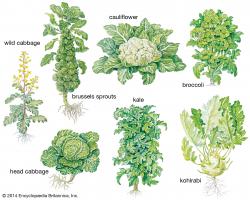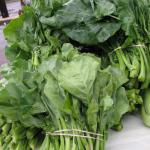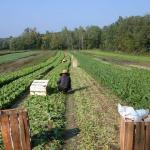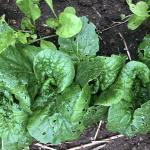Vegetable/Herb of the Week: Brassica Family
Frank Mangan and Heriberto Godoy-Hernandez
To read individual sections of this article, click on the section headings below to expand the content:
Welcome to this sixth article of Franco and Beto’s series on growing your own vegetables and herbs in Massachusetts.
Introduction
The brassica family of plants, also known as crucifers, is an important family of food crops grown around the world, comprised of multiple genera and species. All cultivated brassica food crops are native to Eurasia but are now grown on every continent in the world except Antarctica, which speaks to the resiliency of this crop group.
Plants in the genus and species Brassica oleracea are the most grown brassica grown in Massachusetts. Cultivars of this species include broccoli, cabbage, cauliflower, kale, collards, kohlrabi and “Chinese” broccoli (Figure 1). All B. oleracea crops are also known as “cole crops", which originated from the Latin word caulis, meaning stem or stalk of a plant. B. oleracea originated in the Mediterranean area, where the climate is characterized by dry summers and mild, wet winters. However, like all brassica food crops, B. oleracea crops are now well-adapted to a wide range of climates. In Massachusetts, they grow well in our hot and humid summer weather and can survive frosts. They are also grown successfully in tropical regions of the world: Figure 2 shows cauliflower and broccoli for sale at a market in Havana Cuba. Figure 3 shows collards growing in tropical Brazil. Planted over one year before this picture was taken; the leaves are harvested from the plants as they are needed to avoid the need for refrigeration.
One reason for the large amount of B. oleracea being grown in Massachusetts is due to the large number of Portuguese-speaking groups living in in this state. Massachusetts has the largest number of Portuguese-speaking people in the United States, made up of people originally from Portugal, Brazil, the Azores, and Cape Verde. Collards is a very important ingredient in the cuisine of all these ethnicities, which has represented a tremendous opportunity for commercial farmers in Massachusetts.
 An interesting experience I have had working with the Portuguese-speaking population in Massachusetts, a language I learned as an adult and have used professionally, is understanding the origin of “Portuguese kale soup”, a staple dish among Portuguese in Massachusetts. In Portuguese, “kale” soup is known as caldo verde, translating to “green soup” in English. The word for collards in Portuguese is couve. Somehow, and I never learned exactly how, the word “kale” in English became the dominant word in English for couve. As an example, I have had opportunities to give presentations to Portuguese-speaking populations living in Massachusetts related to work our program does in promoting culturally appropriate nutrition education for different low-income immigrant communities with an emphasis on using locally grown ingredients. Sometimes I’ll show a picture of a field of collards growing next to kale and ask which one is “couve”, and all point to the collards – many don’t even know what kale is (Figure 4)!
An interesting experience I have had working with the Portuguese-speaking population in Massachusetts, a language I learned as an adult and have used professionally, is understanding the origin of “Portuguese kale soup”, a staple dish among Portuguese in Massachusetts. In Portuguese, “kale” soup is known as caldo verde, translating to “green soup” in English. The word for collards in Portuguese is couve. Somehow, and I never learned exactly how, the word “kale” in English became the dominant word in English for couve. As an example, I have had opportunities to give presentations to Portuguese-speaking populations living in Massachusetts related to work our program does in promoting culturally appropriate nutrition education for different low-income immigrant communities with an emphasis on using locally grown ingredients. Sometimes I’ll show a picture of a field of collards growing next to kale and ask which one is “couve”, and all point to the collards – many don’t even know what kale is (Figure 4)!
For more information on different cole crops grown in Massachusetts, go to the New England Vegetable Management Guide on cole crops, including recommended varieties.
There is one prominent member of B. oleracea found in Asian markets in Massachusetts, called gai lan in Cantonese and Chinese broccoli in English (Figure 5). I have never been able to find out how this type of B. oleracea, native to the Mediterranean, became established in Asia (Figure 6).
Asia is another important center of origin for food crops in the brassica family. Many of the brassica crops most important in Asian cuisines are cultivars of the species Brassica rapa. B. rapa crops represent a large percentage of fresh vegetables found in Asian markets (Figure 7). While most B. rapa crops originated in Asia, rutabaga and turnip are exceptions to this rule--both are thought to be crosses between B. rapa and B. oleracea but originated in Russia and Sweden. Asian cabbage (B. napa) is another popular green vegetable in Asian markets and are grown in Massachusetts for these markets. Unlike B. oleracea, B. rapa types do not have a waxy cuticle.
 Radishes (Raphanus sativas), are also in the brassica family and are native to Europe and now grown throughout the world, including the United States. There is an Asian type of radish, called daikon and the same genus and species as the European type, which is also grown in Massachusetts and a staple in Asian markets (Figure 8). For growing information, go to: https://nevegetable.org/crops/radish.
Radishes (Raphanus sativas), are also in the brassica family and are native to Europe and now grown throughout the world, including the United States. There is an Asian type of radish, called daikon and the same genus and species as the European type, which is also grown in Massachusetts and a staple in Asian markets (Figure 8). For growing information, go to: https://nevegetable.org/crops/radish.
One characteristic of the brassica species grown in Massachusetts is that many can be stored at near freezing temperatures (Table 1). This means they have a longer shelf life than some other more “tropical crops” we grow in Massachusetts, such as tomatoes and basil, both of which have a shelf life of only 4 – 7 days.
| Table 1. Handling Produce for Higher Quality and Longer Market Life for Brassica Vegetables Grown in Massachusetts | ||
| Brassica type | Recommended storage temperature (F) | Expected marketable life under best conditions |
| Broccoli | 32 | 1 – 2 weeks |
| Brussel sprouts | 32 | 3 - 5 weeks |
| Cabbage | 32 | 3 - 6 weeks |
| Cabbage, Chinese | 32 | 4 - 8 weeks |
| Collards and Kale | 32 | 1 – 2 weeks |
| Kohlrabi | 32 | 2 - 4 weeks |
| Horesradiah | 30-32 | 1 year |
| Radishes, bunched | 32 | 1 – 2 weeks |
| Rutabegas | 32 | 2 - 4 months |
| Turnips | 32 | 4 - 5 weeks |
| Turnip/Mustard tops | 32 | 1 – 2 weeks |
Production of Brassica Crops
In Massachusetts, B. oleracea types of brassica are normally transplanted due to the lengthy time from seed to harvest; B. oleracea should be started in a greenhouse 4–6 weeks before transplanting into the field. Many farm stands sell transplants of B. oleracea through the spring/early summer. See recommended varieties of cabbage, broccoli, cauliflower and other B. olerecea crops in the New England Vegetable Management Guide at https://nevegetable.org/crops/cabbage-broccoli-cauliflower-and-other-brassica-crops
Insect Problems
Among all insect pests of brassica plants, flea beetles are one of the most difficult to manage for gardeners and organic farmers. More info can also be found under insect management in the New England Vegetable Management Guide about insect pests that are problems in Massachusetts at https://nevegetable.org/crops/insect-control-3
There are two flea beetle species found in Massachusetts, Phyllotreta crucciferae and P. striolata, which are small insects that can be difficult to see, but the damage they cause is unmistakable. Figure 9. I have found flea beetle damage on some of my brassica plants but have yet to see one of the insects, which is not uncommon as they are very small and fly. I know they are active from reading the UMass Vegetable Notes, published weekly during the field season. In their posting on May 7, the UMass Vegetable Team documented flea beetle activity on brassica plants on commercial farms. (As shared earlier, we recommend signing up to receive this publication, which is free. The target audience for this publication is commercial farmers; however, there is useful information relevant to gardeners, such as knowing flea beetles have emerged and information on how to manage them!
 Using row cover to exclude flea beetles from your plants can be an effective management tool. It is critical to get the row cover on before flea beetles emerge in the spring (aka, as soon as your brassica crops are planted) and to “seal” the sides of the row cover with soil so the flea beetles cannot enter; flea beetles both fly and crawl. I usually take off the row cover in my garden in early June since gets too hot under the row cover for some plants I grow. See information on using row covers in article published in this series on May 21.
Using row cover to exclude flea beetles from your plants can be an effective management tool. It is critical to get the row cover on before flea beetles emerge in the spring (aka, as soon as your brassica crops are planted) and to “seal” the sides of the row cover with soil so the flea beetles cannot enter; flea beetles both fly and crawl. I usually take off the row cover in my garden in early June since gets too hot under the row cover for some plants I grow. See information on using row covers in article published in this series on May 21.
Currently I have several brassica species growing in my garden, which I will report on through the season. Here they are organized by genus and species:
- Brassica oleracea
- I had a few plants of Brussel sprouts, which succumbed to a Pythium disease earlier in the season and were removed so as not to infect other plants.
- I have a few broccoli plants, some of which also succumbed to the Pythium disease, but others are now growing well. (Figure 10)
- Brassica rapa
- I had several pac choy plants which I harvested a week ago – they are great in stir fry! Figure 11
- Eruca vesicaria
- Arugula, called rocket in some parts of Europe and rucola in Italy, where it is very popular, including as a toping on pizza. Figure 12 shows one type. Figure 13 shows arugula as a topping on a pizza in Italy, which is common.
- I have transplanted and direct seeded multiple plantings of arugula and am very impressed with their production. They will produce flowers but can still be eaten without becoming too bitter.
“Nutrient Density" Related to Members of the Brassica Family
Many members of the Brassica family are considered very nutritious, which in part is due to the high levels of glucosinolates, a sulfur-containing compound found in all members of this family, which are responsible for the spiciness of some brassica types. For example, horseradish (Armoracia rusticana), known for being very spicy and also a member of the brassica family, has very high levels of glucosinolates (more information on the health benefits of brassicas).
 There was a period when Whole Foods Market listed what is called an ANDI score for all fresh produce, but stopped this practice several years ago. This system to measure the nutrient density of fresh produce was developed by Dr. Joel Furman, and described at http://www.toddlertime.com/health/ANDI_Scores.htm#:~:text=Eat%20Right%20America's%20ANDI%20Scores&text=Aggregate%20Nutrient%20density%20Index%20(ANDI)%20is%20a%20score%20assigned%20to,his%20book%2C%20Eat%20for%20Health.
There was a period when Whole Foods Market listed what is called an ANDI score for all fresh produce, but stopped this practice several years ago. This system to measure the nutrient density of fresh produce was developed by Dr. Joel Furman, and described at http://www.toddlertime.com/health/ANDI_Scores.htm#:~:text=Eat%20Right%20America's%20ANDI%20Scores&text=Aggregate%20Nutrient%20density%20Index%20(ANDI)%20is%20a%20score%20assigned%20to,his%20book%2C%20Eat%20for%20Health.
ANDI is short for Aggregate Nutrient Density Index. As an example, Figure 14 shows “ANDI” scores for 63 different vegetables and fruits on a scale of from 0 to 1,000. I bring this up in an article on the brassica family since many of these foods are in the brassica family, and six of these are B. oleracea. For more information, go to:
https://en.wikipedia.org/wiki/Brassica#:~:text=Brassica%20species%20and%20varieties%20commonly,and%20hybrids%20of%20cultivated%20origin.
Weekly Video Update
Weekly Video Update at Franco's Garden (from 6/19/20)









